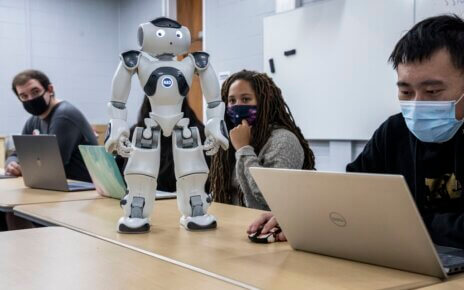Over the past year, the University’s Art and Design Department has evolved with the opening of Rechnitz Hall, and its recently purchased cutting edge technology such as a 3D printer, a laser cutter, and a 3D Scanner.
During the summer, the art department obtained four new pieces of equipment along with a recent update in the department’s sculpture room.
Of the machines added, one was the Makerbot 3D printer, a machine that melts plastic materials and creates 3D objects from a digital file, and is the first machine of its caliber to be used at the University.
Other machines include a laser cutter, which uses lasers to cut through different mediums such as wood, metal and plastic, and a Makerbot 3D scanner, which uses lasers to scan objects and convert them into digital files.
“This digital file can then be used to make a replica of the object with the 3D printer,” said Mike Richison, a specialist professor in the Art and Design Department.
Richison, also has the newly renovated sculpture area, located in the 600 building workshops, for 3D class use.
The area has undergone repainting, wall and flooring repairs, and has received new metal holding racks and work tables for student works and projects.
According to Akil Billy, a senior art education major and study monitor for the art department, the renovations to the area were much needed, especially in such a hands-on atmosphere. “I like the space that the new set up has,” he said.
“Getting rid of the older cabinets and replacing them with the new shelves was a good idea, [since] it helps open up the room giving the feeling of more space as well as creating more usable areas since they are built up and not out,” continued Billy.
But while the new spaces and technologies might look nice, Talia Carney, a junior fine arts major, said that these improvements are crucial for students to be able to learn the skills needed for their respective fields.
“The sculpture rooms are very old and have a comfortable feel. However rooms like that are fragile and sometimes it is difficult to open drawers and cabinets. Learning and using all older techniques is nice however students need to know what the current techniques and how to master them are,” said Carney.
The art department as of late isn’t any stranger to updates and restoration efforts to the department. Andrew Cohen, Chair of the Art and Design Department, said, “The facilities are excellent. We have Mac labs designated for the use of graphic design, animation, and photography students. These labs have the most updated software, such as Adobe Creative Cloud. Additionally we have renovated studios for ceramics, and sculpture, and we maintain both digital and analogue studios for photography.”
And while the technologies are being used to teach students they are also allowing students to create finer art pieces for their portfolios. “I have used the laser cutter in my printing class. The laser cutter is very exciting because it stops students from feeling limited with their designs because the laser is very helpful with the finer details. It is much easier to achieve the smaller designs and fine line,” said Carney.
Vincent DiMattio, a professor in the art and design department, has been able to see the expansion of the University and the art department in his 47 years teaching at Monmouth. “I’ve not only seen tremendous growth in what was back then simply called the art department, but tremendous growth campus wide. I was here when the school was still Monmouth College, [and] I’ve seen pretty much all of the major changes since 1968,” he said.
According to Billy, despite the changes that the art department undergoes he believes the content of what is being taught in the end is more important than the fancy changes.
“Yes, work environment plays a major part in learning but most times simple accommodations usually work fine, [and] when the means come to improve the studios, they should take it,” Billy said. “Improving the studios will go a long way in attracting future students, but the ‘technology’ and content, I feel, will keep them here.”
PHOTO COURTESY of Jamilah McMillan



